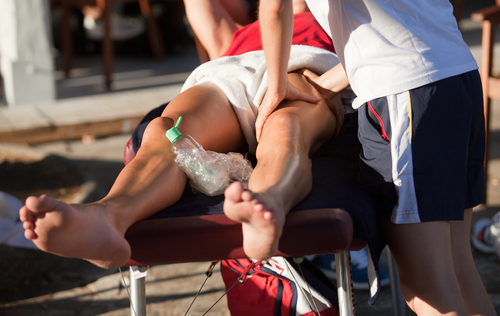MS Foot Drop and the Road to Physiatry


When I first heard about MS “foot drop,” I assumed that the manifestation of this symptom would be a sudden and obvious inability to walk properly. I knew many people with MS who used canes and walked with significant stiffness or a “dragging” limb. I filed “foot drop” away for future reference and eased on down the road. Many years passed, and aside from some trouble walking due to balance issues, my feet and legs were fine. In fact, the lack of walking difficulty caused many a surprised or skeptical look when I said that I had MS.
In the spring of 2011, on the eight-year anniversary of my diagnosis, I took a family trip to Phoenix. We attended baseball games, toured the botanical garden, and even went dancing. A rookie choice of pink satin flip-flops on the dance floor led to a rolled ankle. Back home, I faithfully rested and iced. But daily severe muscle spasms began to affect my foot and calf, so painful that they could drop me to the floor and leave me there for up to a half hour. Summer arrived and I was worse, not better. It was my right leg, and driving became unbearable. Despite icing throughout the work day, the 20-minute drive home was excruciating. I over-used my cruise control and employed the breathing tricks learned for childbirth over a decade ago. I was frequently crying before I made it in the front door.
Something was very wrong and the neurologist, naturopath, and physical therapist couldn’t seem to put Judy back together again. I was discouraged, and some days devastated. Not only was it difficult to work and function as a parent, but I was unable to do my usual outdoor activities that lift my emotional and spiritual health. The neurologist mentioned possible “foot drop,” but was not certain. The PT was very doubtful that the problem was related to my MS. In August, depressed and desperate, I received my first ever IV Solu-Medrol treatment and a referral to a physiatrist.
The National MS Society describes a physiatrist as a physician with expertise in physical medication and rehabilitation, who may serve as the leader of a rehabilitation team. I had never heard of a physiatrist! My initial appointment and exam took an hour and a half. The doctor patiently assessed the smallest movements, as well as my standing, walking, flexing, and stretching. She had reviewed the other providers’ notes prior to my visit, and asked many additional questions to gain a detailed understanding of my symptom history.
I left her office that day with an official diagnosis of MS “foot drop.” She explained that the changes can start slowly and subtly. The muscles in my right calf had not been receiving the full message from my brain for a while. As a result, the muscles on my shin were working harder. Our bodies are very polite and tend to help without being asked … muscles compensate for each other. The muscles on the front of my leg had grown in size and strength, but were simply not designed to do this work. As a result, I had developed chronic shin splints and spasms.
We needed to give them a break. Hand controls for the car would save my leg muscles for the more useful and beneficial activity of walking. An ankle-foot orthosis, or AFO, brace would use kinetics to lift my toes for me as I walked. (I use the AFO, but there are also newer functional electrical stimulation, or FES, braces. Read about them here.) Hopefully with enough rest I would be able to modify my hikes and enjoy the outdoors again.
It all sounded too good to be true. Ironic, isn’t it? I had developed a new manifestation of my disease and it sounded too good to be true! I was truly relieved to have some answers and a plan. By October I had the brace and hand controls, and by November the daily pain was gone. It was an adjustment, but these tools have helped me regain much.
Just remember — foot drop may not arrive with a bedazzled cane and a boom … it may creep in quietly with shin splints and foot cramps, or masquerade as an ankle sprain. For any MS rehabilitation needs, I hope that my story might help others to find the yellow brick road that leads to a physiatrist sooner than I did!
Note: Multiple Sclerosis News Today is strictly a news and information website about the disease. It does not provide medical advice, diagnosis, or treatment. This content is not intended to be a substitute for professional medical advice, diagnosis, or treatment. Always seek the advice of your physician or other qualified health provider with any questions you may have regarding a medical condition. Never disregard professional medical advice or delay in seeking it because of something you have read on this website. The opinions expressed in this column are not those of Multiple Sclerosis News Today, or its parent company, Bionews Services, and are intended to spark discussion about issues pertaining to multiple sclerosis.







Michael Adams
The link mentions the Walkaide. I'm a person with MS and foot drop. I began using the Walkaide 3.5 years ago. Two comments. For me, I feel like it was a life saver. I can walk, play golf, hike with it. In the beginning, I wore it all day, everyday. After about six months, the muscle tone in the affected leg improved substantially as did the girth of the calf. Now I only wear it when I plan to walk more than about two miles.
I also was able to get Blue Cross of N.C. to pay for it (multiple appeals). It took a LOT of effort but they did finally pay.
Judy
Thank you so much for these comments, Michael. I may explore an FES like the Walkaide. The AFO brace that I use doesn't allow me to hike with any inclines, though I am able to do shorter hikes without it on good days. It also doesn't 'use' the muscles that aren't working, so unlike you, my right calf is shrinking!
Notime Forbs
Sadly we are insured by the largest west coast HMO. They throw us opiates and send us packing. Worse yet, we pay over $1400/mo for this "treatment". I believe the standard back alley drug dealer would be more cost effective!
Judy Lynn
I also have an HMO that says they do not cover a FES brace. I am going to do some research and talk to my healthcare team about it. I've never used the appeal process, it may be worth a try.
Nancy Arnone
I was evaluated for a Walkaide a few months ago....it worked so well for me...I was falling in at least 2/3 times a week without it but when I used it I never fell...I used it all day and soon was walking without the walker and just using a cane....I paid to use it for a monnth but had to return it because my insurance didn't pay for it and I couldn't pay the 3000.00 plus for it..I was able to get 1 from a friend that bought it and couldn't use it..trouble was I can't find any place to reprogram it for me...is there anything I can do to get it done...thanks falling all the time again now
Judy
Notime- maybe Michael can give us some tips on getting our insurance to cover it. I also have a very large HMO that says they do not cover it. It may be worth a fight!
Judy Lynn
Nancy, thank you for sharing this story. How wonderful that you were able to get one from a friend! It makes me curious if there are organizations that offer a 'recycling' program of sorts for adaptive equipment.
I don't know who does the reprogramming, perhaps if you call the manufacturer they can direct you? I've also found the Navigators at the National MS Society to be very helpful with tracking down answers.
Nancy Arnone
Judy..I have contacted many place that do this programing but none will do it for anyone than the owner....I have the manual for the programing but not a geek so can't do it....back to falling all the time..
Violet W.
My son has MS foot drop (Secondary Multiple Sclerosis) going on 18 years since diagnosis of MS as RRMS. The foot drop occurred more than six or seven years ago. He got a left foot accelerator for his car and that is a lot less expensive than hand controls. If you have problems with your hands or arms then that doesn't work. Here in NE NC you have to get special training for either hand controls or left foot accelerators and we have only one in this area and it's very expensive to get the certification as well. He has tried the adaptive braces and found them too bulky and uncomfortable, plus he had to buy two pairs of shoes as the brace requires a larger shoe. The drag has increased however, and in order to maintain his independence (shopping, etc.) we are now waiting for an approval from Medicaid for a power wheelchair. The problem is that for people living on SSI, even a power wheelchair doesn't help without having the money for a carrier for the car........Medicaid help you get the wheelchair you need for independence but won't help pay for getting that wheelchair anywhere outside your home.
Judy Lynn
Hi Violet- I am glad that your son was able to get some vehicle adaptations (you taught me something new- a left foot accelerator!) I was fortunate that my state's Department of Vocational Rehabilitation supported the adaptations to my vehicle because I use the car for work.
I hope that he is approved for the power chair soon. I encourage you to check with local and national non-profits like the National MS Society for help with vehicle modifications. And keep asking around on these MS websites and blogs- maybe someone out there has a suggestion!
Liz Merry
Thank you for this article. I spent two years rolling my left ankle, stubbing my toe, tripping and falling before I read the term "Foot Drop." I would tell my various doctors about how "My left foot doesn't work," or "My left lower leg is weak." But no one named the problem, so I couldn't treat it!
Judy Lynn
Thanks for sharing your story Liz- I am amazed that it isn't caught and treated sooner, as it's such a common symptom of MS. I think the providers are not trained to look for the early and subtle changes.
Jennifer
I have a mild case of foot drop related to my MS (diagnosed 3 years ago). I try to walk at least 5km every day with my husband to stay active but it was getting really annoying dragging my foot along behind me. I came across this little thing called a Flopstop. It was invented by a guy who has MD as MD patients can also unfortunately suffer from severe foot drop. It's really helped me to continue with my daily walks on days where my foot drags a lot and my leg feels weak - it gives me a little extra lift. It was really cheap and I don't have to explain to anyone why/what I am wearing, which I really like. I don't know that it would help with really severe foot drop, but then again I can't say it wouldn't either. Just thought I would share!
Tim Bossie
Hi Jennifer! Thank you for sharing your experience and the solution that has helped you. I find it exciting to know that what has been developed for other illnesses and conditions is good for others as well. We do hope you continue to have good results with the Flopstop and keep taking those walks!
Stephanie
’m having a lot of pain in my shins and ankle during the day and at night. I googled shin splints, ankle pain, and ms and found your article. I will definitely call my neurologist first thing Monday morning to discuss a treatment plan.
I’ve been rather depressed about the whole situation especially today since I can’t join my husband on our unusual Sunday hikes. I feel so encouraged that there are options.
stephanie wolff
You described my situation to a tee. First I started skipping Sunday hikes, then morning walks with our dog, and then no walks at all . I now wear the Bioness GO Leg cuff and I’m so happy to be active again !